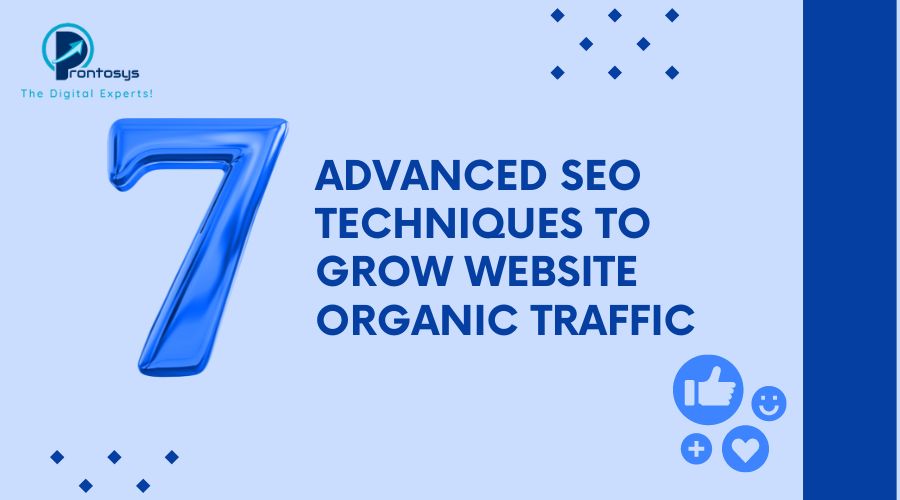Growing organic traffic to your website is a crucial goal for any online business or content creator. Organic traffic means visitors are finding your site through search engines like Google without you having to pay for ads. This blog will cover seven advanced SEO techniques that can help you achieve this goal. The techniques discussed are easy to understand and apply, making them suitable for everyone, regardless of their technical skills.
Understanding Advanced SEO Techniques
SEO (Search Engine Optimization) is all about making your website more visible to search engines. When your site ranks higher in search engine results, it attracts more visitors. This blog will explore advanced techniques that go beyond the basics, helping you to significantly boost your website’s organic traffic.
Technique 1: Optimize for Voice Search
Voice search is becoming increasingly popular. With devices like smartphones and smart speakers, people are now using voice commands to search for information online. Optimizing your website for voice search can help you capture this growing audience.
Note:- Are you prepared to increase the organic traffic to your website? Partner with ProntoSys, the leading experts in SEO Dubai. Our specialized tactics will raise your company’s search engine ranks and increase website traffic. Reach out to us right away to get started on your SEO adventure and see your web presence take off! To begin, go to our website or give us a call right now.
How to Optimize for Voice Search
- Use Conversational Language: Write your content in a natural, conversational tone. People use voice search differently than typing, often asking full questions.
- Include Question Phrases: Add questions and answers to your content. Think about the questions people might ask about your topic.
- Focus on Long-Tail Keywords: These are longer, more specific keyword phrases that people use in voice searches.
Technique 2: Improve Page Load Speed
Page load speed is a critical factor in both user experience and SEO. A faster website can lead to higher search rankings and more satisfied visitors.
Steps to Improve Page Load Speed
- Compress Images: Use tools to reduce the file size of images without losing quality.
- Enable Browser Caching: This allows returning visitors to load your site faster.
- Minimize HTTP Requests: Reduce the number of elements on your page that require loading, such as scripts and images.
Technique 3: Implement Schema Markup
Schema markup is a code that you put on your website to help search engines understand your content better. It can improve how your pages are displayed in search results.
Benefits of Schema Markup
- Enhanced Search Listings: Schema markup can make your search listings more attractive by adding elements like star ratings and images.
- Better Click-Through Rates: Improved search listings can lead to higher click-through rates.
- Rich Snippets: These are additional details shown in search results, like reviews and event times, which can make your listing stand out.
Technique 4: Focus on Mobile SEO
With more people using mobile devices to access the internet, having a mobile-friendly website is essential. Google also prioritizes mobile-friendly sites in its search rankings.
Making Your Site Mobile-Friendly
- Responsive Design: Ensure your website design adapts to different screen sizes.
- Fast Mobile Loading: Optimize your site to load quickly on mobile devices.
- Mobile-Friendly Content: Use larger fonts and easy-to-click buttons for a better mobile experience.
Technique 5: Create High-Quality Content
Content is king in SEO. Creating high-quality, engaging content can attract more visitors and encourage them to stay longer on your site.
Tips for Creating High-Quality Content
- Understand Your Audience: Write content that addresses the needs and interests of your target audience.
- Use Clear and Simple Language: Avoid jargon and complicated words.
- Include Visuals: Use images, videos, and infographics to make your content more engaging.
- Update Regularly: Keep your content fresh and up-to-date.
Technique 6: Build Quality Backlinks
Backlinks are links from other websites to your site. They are a crucial factor in SEO, as they show search engines that your site is trustworthy and authoritative.
Strategies for Building Quality Backlinks
- Guest Blogging: Write articles for other websites in your niche and include a link back to your site.
- Create Shareable Content: Produce content that others want to link to, such as informative articles, infographics, and videos.
- Reach Out to Influencers: Connect with influencers in your industry and ask them to share your content.
Technique 7: Utilize Social Media
Social media can drive significant traffic to your website and improve your SEO. While social signals are not a direct ranking factor, they can help increase your content’s visibility and engagement.
Effective Use of Social Media for SEO
- Share Your Content: Regularly share your blog posts and other content on social media platforms.
- Engage with Your Audience: Respond to comments and messages to build a community around your content.
- Use Hashtags: Include relevant hashtags to increase the reach of your posts.
- Collaborate with Others: Partner with other content creators and influencers to expand your audience.
Conclusion
Implementing these advanced SEO techniques can significantly boost your website’s organic traffic. By optimizing for voice search, improving page load speed, using schema markup, focusing on mobile SEO, creating high-quality content, building quality backlinks, and utilizing social media, you can make your website more attractive to both search engines and visitors. Remember, SEO is an ongoing process, so continue to refine and adapt your strategies to stay ahead of the competition.
Read more informative blogs at relxnn









